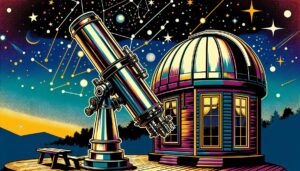This site contains affiliate links to products. I may receive a commission for purchases made through these links.
Ever gazed at the night sky and wished you could capture its beauty? I’ve been there. That’s why I’m sharing my knowledge on creating your own star maps using software tools. It’s easier than you think, and the results are simply stunning.
There’s a galaxy of software out there designed to help you chart the stars. Whether you’re an amateur astronomer or just someone who loves the night sky, there’s a tool that’s right for you. In this guide, I’ll walk you through some of the best ones available.
So, let’s dive in and start creating your very own star maps. Trust me, it’s an adventure you won’t want to miss.
Choosing the Right Software Tool
Over the years, I’ve immersed myself in a myriad of software tools for creating star maps. Choices abound, from quick and easy mobile apps to powerful and detailed PC programs. It’s thrilling! Yet, it’s also testing since finding the right tool to suit your needs can feel like looking for a constellation in a sky full of stars.
Whether you’re a passionate amateur astronomer or a casual stargazer, one fundamental factor to consider when choosing the right software tool is your specific requirement. Ask yourself, what do you want to achieve? Is it the simple joy of exploring the night sky or are you on the quest for finding deep-space objects?
Let me share with you some of the favored go-to’s classified according to user’s objectives:
- Red-shift 8: Known for its simplicity, ideal for newbie stargazers. It has a benefit of the visual tour of our Galaxy.
- Starry Night Pro: This is a highly detailed software with precision necessary for amateur astronomers.
- Sky Safari: Best suited for on-the-go people who love stargazing. It is an easy-to-use mobile app having the perks of point and locate feature.
| Software | Ideal For | Feature |
|---|---|---|
| Red-shift 8 | Newbie | Visual tour |
| Starry Night Pro | Amateur Astronomers | Detailed |
| Sky Safari | On-the-go people | Point and locate |
Of course, these are just a few of the many programs out there. The software market is as vast and varied as the cosmos itself. Find a tool, play around with it and figure out whether it caters to your needs. Remember, your star mapping journey is a personal expedition. Choose a software that bestows upon you the universe in the way you wish to discover it.
Note: Free trials are available for most software tools. So, take advantage of this feature before plunging into a purchase. Take your time and cherry-pick the tool you feel most comfortable with. Happy stargazing!
As we progress to the next section, let’s delve deeper into how to effectively use these software tools to create your star maps.
Understanding Your Needs and Goals
As you journey into the realm of stargazing software, it’s crucial to understand your needs and goals. Selecting the right tool can help elevate your stargazing experience, but the key is to know what you’re looking for.
Beginner or Advanced?
Are you a starry-eyed beginner, mesmerized by the night sky and hoping to identify a few constellations? Or are you a well-seasoned astronomer, in search of detailed star charts and accurate sky simulations? Knowing your skill level will help narrow down your software choices.
Let’s consider some essential factors:
- For Beginners: Easy-to-use interfaces, simple graphics, basic informational resources are your best bets.
- For Advanced users: Detailed sky simulations, accurate star chart generation, customizable viewing options are a must.
Indoor or Outdoor Viewing?
Next, think about where you’ll be doing most of your stargazing. It makes a notable difference in software selection.
- For Indoor viewing: Choose software with high quality graphics and immersive simulations to experience the sky’s wonder indoors.
- For Outdoor viewing: Opt for software that enhances real-time viewing. Features like night mode could also be beneficial.
Free or Paid Software?
Thinking about how much you’re willing to invest in your software is another important consideration. There’s a mix of free and paid software out there, and both have their merits.
- Free Software: Many offer excellent basics and a restricted array of advanced features.
- Paid Software: Generally provide more comprehensive features and regular updates. Pricing may vary greatly, so weigh functionalities against fees before making a decision.
Remember, this starry pursuit is all about personal enjoyment and education. It’s about finding the right balance between your interests, skill level, stargazing conditions and resources. Keep your needs and goals firm in mind as you sift through software options. After all, the skies have a lot more to offer when you’re looking through the right lens (software, in this case!).
Exploring Different Software Options
Embarking on the journey of stargazing software selection, it’s necessary to evaluate numerous options available on the market. As I delve into the variety of software, remember no one-size-fits-all solution exists, it’s about finding what suits your specific needs.
Stellarium surfaces as a popular choice for beginners and experts alike, offering an extensive catalogue of stars and constellations in an engaging, interactive 3D platform. It’s an open-source software available at no expense, making it a great option for those with a stringent budget. Plus, it functions seamlessly both indoors and outdoors!
For a more advanced experience, options like Starry Night and SkySafari Pro come into play. These are premium tools offering more depth in celestial exploration, including a comprehensive database of celestial bodies, comprehensive light pollution maps and advanced telescope control. As premium tools, they come with a price tag- but offer an immersive, comprehensive stargazing experience.
I can’t overlook mentioning the online tool Google Sky. It’s a free, user-friendly tool offering a vivid, interactive cosmic exploration. However, being an online tool, you’d need a stable internet connection- something to bear in mind while planning your stargazing.
| Software | Type | Budget | Indoor/Outdoor Suitability |
|---|---|---|---|
| Stellarium | Open-source | Free | Both |
| Starry Night and SkySafari Pro | Premium | Paid | Both |
| Google Sky | Online | Free | Indoor (Requires Stable Internet) |
The journey through stargazing software is a beautiful intertwine of personal preference, technical aptitude, and financial resources. Therefore, it’s important to adopt a flexible approach and be open to experimentation along the road- after all, your ultimate goal is to find satisfaction in the canvas of stars that the night sky offers!
Remember, this is an ongoing journey, an exciting exploration where stargazing software is your guide, leading you towards an enriching experience of the cosmos. As we move forward, I’ll delve into specific features of these tools in detail.
Features to Look for in Star Map Software
Choosing the perfect star map software can make your astronomical adventures infinitely more exciting. There’s a myriad of tools available, each brimming with unique features and capabilities. Let’s delve right into the must-have features you should consider when selecting a stargazing app.
Star map software should be accurate and up-to-date. Look for an application that provides precise information about celestial bodies and events. Apps with auto-updating features ensure you’re always looking at the most current star maps. This accuracy is vital for both casual stargazers and serious astronomers.
Ease of use is a major factor. As a star gazer, you’d want software that’s friendly and intuitive, not just crammed with features. Whether you’re a beginner or an expert, the software should allow you to navigate the star maps with ease.
Let’s not forget about the feature of personalized view options. The ability to customize your views, zoom-in, pan around, and even change the view settings to mimic different locations on earth makes a star map software stand out.
Next, the software should provide additional data about the objects in the sky. It’s not only about knowing where the celestial objects are. Information like their histories, the mythology associated with them, and the specs of telescopes needed for viewing adds a special flavor to stargazing.
Moreover, the integration of real-time observation tools can significantly amplify your stargazing experience. Features such as radar overlay, weather updates, and moon phase trackers help in predicting viewing conditions and planning your stargazing sessions.
Let’s list these features for a quick look:
- Accurate and updated star maps
- User-friendly interface
- Personalized view options
- Additional data and trivia
- Real-time observation tools
By considering these features in your selection, you can make the most of your stargazing experience. Remember to remain open to new developments and upgrades in the software. It’s not about finding the perfect app today, but about staying updated with technological advancements tomorrow.
Tips and Tricks for Creating Stunning Star Maps
Here’s where we dive into some nitty-gritty of star map creation. With the right software, you’ve got an entire universe at your fingertips. But, how can you effectively transform raw celestial data into an awe-inspiring star map? I’d love to share some tips and tricks I’ve gathered throughout my star-gazing years.
Familiarity with your software tool is a basic imperative. You’ll be seeing a lot of real-time celestial data, and knowing where to click and what to tweak yields momentous results. Practice intensely, and make sure you’re comfortable with the software’s functions and features.
Use the highest resolution settings your software allows, but remember your computer’s limitations. High-resolution star mapping requires a well-oiled and capable machine. You don’t want any lags disrupting your journey through the Milky Way.
Next, pay special heed to the color options available. Certain colors present a more realistic depiction of the night sky. Colors like deep blue, black, and varying tones of gray best imitate a naturally dark sky. Conversely, brighter star colors tend to stand out more effectively against these darker backgrounds. Use your discretion.
Personalise your view settings to your preference. Whether you opt for a zenith point view, horizon view or even a quirky wormhole view, the view you choose becomes your signature. Embrace that individuality.
While a detailed map is always fascinating, do not clutter your star map. Show restraint while adding additional celestial bodies, constellations, and astronomical lines. A balanced star map isn’t overloaded; it strikes a serene balance between minimal and detailed.
There’s no end to learning when it comes to mapping the stars and our software develops progressively. Tomorrow, new features may await. Don a stargazer’s curiosity; always be open to software upgrades and keep evolving your skills. In doing so, you constantly renew the pleasure involved in creating your personal celestial masterpiece.
After all, there’s an entire universe out there to explore. The possibilities are truly interstellar.
Conclusion
I’ve shared my knowledge on creating star maps and the software tools you’ll need. Remember, it’s all about getting comfortable with your chosen software, maximizing its features like high-resolution settings and color options. Don’t be afraid to personalize your view settings and keep your designs clear of clutter. As you master these tools, you’ll find your star maps becoming more and more impressive. And don’t stop there. Embrace software updates—they’re opportunities to learn and evolve. Keep pushing your skills forward, always striving to create the next celestial masterpiece. With time and practice, you’ll be creating star maps that not only map the skies but also chart your journey as a stargazing artist.
Frequently Asked Questions
What is the main focus of the article?
The article primarily focuses on providing readers with tips and tricks on creating magnificent star maps.
What is the importance of being familiar with the software tool in star mapping?
Understanding the software tool thoroughly can enhance your ability to create detailed, high-quality star maps.
Why should high-resolution settings be used?
High-resolution settings allow for a clearer, more detailed star map, improving the overall visual experience.
How does color choice impact a star map?
Appropriate color choice can highlight particular features and areas in the star map, making it visually appealing and easier to understand.
What does the article say about view settings?
The article stresses the importance of personalizing view settings as per your preferences, to enhance the overall star map creating experience.
What should we do to avoid clutter in our star maps?
Avoiding unnecessary or irrelevant elements in your star maps can prevent clutter, making your star map more comprehensible and visually striking.
Why does the article encourage software upgrades?
Keeping your software updated allows you to take advantage of new features and improvements, thereby enabling you create more intricate and precise star maps.
What does it mean to constantly evolve your skills?
The article suggests that continuously learning and improving your skills will help you create better and more complex star maps, reflecting your growth and development over time.



